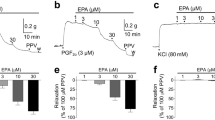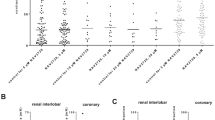Abstract
Arachidonic acid-induced platelet aggregation was inhibited by prostaglandins E1 and F2α (PGE1 and PGF2α), papaverine and dibutyryl cyclic AMP. Prostaglandin E2 displayed a biphasic effect, as concentrations below 2 μM potentiated aggregation, whereas concentrations above it were inhibitory. Isoproterenol (up to 10 mM) failed to block aggregation but inhibition was uncovered in presence of adrenergic α-blocking agents. Isoproterenol potentiated aggregation due to sub-threshold amounts of arachidonic acid, and this effect, but not that due to PGE2, was suppressed by the α-blocking agents. Isoproterenol and PGE2 appear thus to enhance arachidonic acid-induced platelet aggregation after interacting with different receptor sites. The yield of rabbit aorta contracting activity formed during AA-induced aggregation was markedly reduced by PGE1, dibutyryl cyclic AMP and high concentrations of PGE2, and was increased by low concentrations of the latter. PG-like activity was not significantly reduced when aggregation and generation of rabbit aorta contracting activity were inhibited by bibutyryl cyclic AMP. It is hypothesized that interaction of human platelets and arachidonic acid results in formation of different pharmacologically active materials, possibly bearing similar lipoperoxide structures. Generation of one portion of these materials is controlled by the adenyl cyclase-cyclic AMP system, whereas another portion, that comprises the natural PG, is cyclic AMP-independent. Prostaglandins formed during platelet aggregation have a regulatory role and modulate the platelet response, rather than constitute a trigger stimulus for aggregation.
Similar content being viewed by others
References
H.R. Bourne, L.M. Lichtenstein, K.L. Melmon, C.S. Henney, Y. Weinstein andG.M. Shearer,Modulation of Inflammation and Immunity by Cyclic AMP, Science184, 19–28 (1974).
J. Kloeze,Influence of Prostaglandins on Platelet Adhesiveness and Platelet Aggregation, in:Prostaglandins, Nobel Symposium 2 (Eds. S. Bergström and B. Samuelsson; Almquist and Wiksell, Stockholm 1967), p. 241–252.
B.B. Vargaftig andP. Zirinis,Platelet Aggregation Induced by Arachidonic Acid is Accompanied by Release of Potential Inflammatory Mediators Distinct from PGE 2 and PGF 2a , Nature New Biol.244, 114–116 (1973).
J. Clausen andK.C. Srivastava,The Synthesis of Prostaglandins in Human Platelets, Lipids7, 246–250 (1972).
B.B. Vargaftig andN. Dao Hai,Paradoxical Inhibition of the Effects of Bradykinin by some Sulfhydryl Reagents, Experientia28, 59–62 (1972).
R. Gryglewski andJ.R. Vane,The Release of Prostaglandins and Rabbit Aorta Contracting Substance (RCS) from Rabbit Spleen and its Antagonism by Anti-Inflammatory Drugs, Br. J. Pharmac.45, 37–47 (1972).
B.B. Vargaftig andN. Dao,Release of Vasoactive Substances from Guinea-Pig Lungs by Slow-Reacting Substance C and Arachidonic Acid, Pharmacology6, 99–108 (1971).
J.B. Smith andA.L. Willis,Aspirin Selectively Inhibits Prostaglandin Production in Human Platelets, Nature New Biol.231, 235–237 (1971).
J.R. Vane,Inhibition of Prostaglandin Synthesis as a Mechanism of Action for Aspirin-Like Drugs, Nature New Biol.231, 232–235 (1971).
A.L. Willis,Platelet Synthesis of Pro-Aggregating Material from Arachidonate and its Blockade by Aspirin, CirculationXLVIII, Suppl. IV–55 (1973).
B.B. Vargaftig, Y. Tranier andM. Chignard,Inhibition by Sulfhydryl Agents of Arachidonic Acid-Induced Platelet Aggregation and Release of Potential Inflammatory Substances, Prostaglandins8, 133–156 (1974).
B.B. Vargaftig, Y. Tranier andM. Chignard,Blockade by Metal Complexing Agents and by Catalase of the Effects of Arachidonic Acid on Platelets: Relevance to the Study of Anti-Inflammatory Mechanisms, Eur. J. Pharmac., accepted for publication (1975).
G.V.R. Born,Aggregation of Blood Platelets by Adenosine Diphosphate and its Reversal, Nature194, 927–929 (1962).
J.R. Vane,The use of Isolated Organs for Detecting Active Substances in the Circulating Blood, Br. J. Pharmac.23, 360–373 (1964).
H. Shio andP.W. Ramwell, Effect of Prostaglandin E2 and Aspirin on the Secondary Aggregation of Human Platelets, Nature New Biol.236, 45–46 (1972).
E.W. Salzman, P.C. Kensler andL. Levine,Cyclic 3′,5′-Adenosine Monophosphate in human Blood Platelets, Ann. N.Y. Acad. Sci.201, 61–71 (1972).
L. Triner, Y. Vulliemoz, I. Schwartz andG.G. Nahas,Cyclic Phosphodiesterase Activity and the Action of Papaverine, Biochem. Biophys. Res. Comm.40, 64–69 (1970).
T. Posternak, E.W. Sutherland andW.F. Henion,Derivatives of Cyclic 3′,5′-adenosine Monophosphate, Biochim. Biophys. Acta65, 558–560 (1962).
R.J. Haslam andM.D. Mc Glenaghan,Effects of Collagen and of Aspirin on the Concentration of Guanosine 3′,5′-cyclic Monophosphate in Human Blood Platelets: Measurement by a Prelabelling Technique, Biochem. J.138, 317–320 (1974).
M. Kaliner andK.F. Austen,Cyclic Nucleotides and Modulation of Effector Systems of Inflammation, Biochem. Pharmac.23, 763–771 (1974).
E. Gillespie, M.D. Valentine andL.M. Lichtenstein,Cyclic AMP Metabolism in Asthma: Studies with Leukocytes and Lymphocytes, J. Allergy clin. Immun.53, 27–33 (1974).
L.J. Ignarro, T.F. Lint andW.J. George,Hormonal Control of Lysosomal Enzyme Release from Human Neutrophils, J. exp. Med.139, 1395–1414 (1974).
L.M. Lichtenstein andS. Margolis,Histamine Release in vitro: Inhibition by Catecholamines and Methylxantines, Science161, 902–903 (1968).
M. Hamberg, J. Svensson, T. Wakabayashi andB. Samuelsson,Isolation and Structure of two Prostaglandin Endoperoxides that Structure of two Aggregation, Proc. Nat. Acad. Sci.2, 345–349 (1974).
A.L. Willis, F.M. Vane, D.C. Kuhn, C.G. Scott andM. Petrin,An Endoperoxide Aggregator (Lass), Formed in Platelets in Response to Thrombotic Stimuli, Prostaglandins8, 453–507 (1974).
M. Hamberg, P. Hedqvist, K. Strandberg, J. Svensson andB. Samuelsson,Prostaglandin Endoperoxides IV. Effects on Smooth Muscle, Life Sci.16, 451–462 (1975).
R. Gryglewski andJ.R. Vane,The Generation from Arachidonic Acid of a Rabbit Aorta Contracting Substance (RCS) by a Microsomal Enzyme Preparation which also Generates Prostaglandins, Br. J. Pharmac.46, 449–457 (1972).
T. Dakhil andW. Vogt,Hydroperoxyde als Träger der darmerregenden Wirkung hochungesättigter Fettsäuren, Arch. exp. Path. Pharmak.243, 174–186 (1962).
S.H. Fereira andB.B. Vargaftig,Generation of Rabbit Aorta Contracting Substance in Blood by Slow Reacting Substance C and its Blockade by Non-Steroid Anti-Inflammatory Drugs, Biorheology10, 288–289 (1973).
S.H. Ferreira andB.B. Vargaftig,Inhibition by Non-Steroid Anti-Inflammatory Agents of Rabbit Aorta Contracting Activity Generated in Blood by Slow Reacting Substance C, Br. J. Pharmac.50, 543–551 (1974).
M. Hamberg, J. Svensson andB. Samuelsson,Prostaglandin Endoperoxides. A New Concept Concerning the Mode of Action and Release of Prostaglandins, Proc. Nat. Acad. Sci.71, 3824–3828 (1974).
M.J.G. Harrison, P.R. Emmons andJ.R.A. Mitchell,The Effect of Sulfhydryl and Enzyme Inhibitors on Platelet Aggregation in vitro, Thromb. diath. haemorrh.16, 122–133 (1966).
N. Baker andL. Wilson,Inhibition of Tumor Glycolysis by Hydrogen Peroxide Formed from Autoxidation of Unsaturated Fatty Acids, Biochem. Biophys. Res. Comm.11, 60–64 (1963).
S. A. Saeed andB. T. Warren,On the Mode of Action and Biochemical Properties of Anti-Inflammatory Drugs-I, Biochem. Pharmac.22, 1965–1969 (1973).
D.C.B. Mills andG.C.K. Roberts,Effects of Adrenaline on Human Blood Platelets, J. Physiol. Lond.193, 443–453 (1967).
Y.H. Abdulla, β-Adrenergic Receptors in Human Platelets, J. Atheroscler.9, 171–177 (1969).
B.B. Weksler, M. Gillick andJ. Pink,Propranolol as an Inhibitor of Platelet Aggregation: Membrane Action, Blood44, 918 (1974).
Author information
Authors and Affiliations
Rights and permissions
About this article
Cite this article
Vargaftig, B.B., Chignard, M. Substances that increase the cyclic AMP content prevent platelet aggregation and the concurrent release of pharmacologically active substances evoked by arachidonic acid. Agents and Actions 5, 137–144 (1975). https://doi.org/10.1007/BF02027355
Received:
Revised:
Issue Date:
DOI: https://doi.org/10.1007/BF02027355




